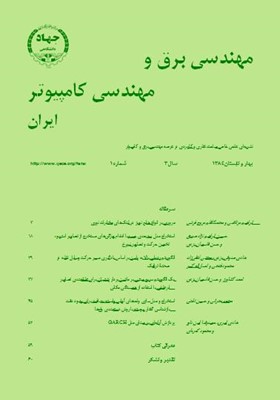پردازش آرايهاي بر مبناي مدل GARCH
محورهای موضوعی : مهندسی برق و کامپیوترهادی امیری 1 * , حمیدرضا امین داور 2 , محمود کمرهای 3
1 - دانشگاه صنعتی امیرکبیر
2 - دانشگاه صنعتی امیرکبیر
3 - دانشگاه تهران
کلید واژه: پردازش سيگنال آرايهايتخمين سمت ورودتخمين حداكثر احتمالGARCH Cramer-Rao Bound,
چکیده مقاله :
در مقاله حاضر، يك مدل جديد براي نويز جمعشونده براساس سريهاي زماني GARCH در پردازش سيگنال آرايهاي ارائه شده است. در بسياري از روشها بدلايلي همچون پيچيدگيهاي پيادهسازي و محاسباتي توزيع احتمال نويز، گوسي فرض ميشود. بررسيها و اندازهگيريهاي انجام گرفته براي نويز محيطي در كاربردهاي مختلف، نشان از غيرگوسي بودن آن دارد و در شرايط واقعي كارايي روشهايي كه مبتني بر مدل گوسي نويز هستند، كاهش مييابد. از مهمترين ويژگيهاي فرآيند نويز محيطي دنبالهدار بودن (Heavy Tail) توزيع احتمال و تغيير ويژگيهاي آماري آن (مانند واريانس) در محيط ميباشد. از طرف ديگر فرآيند GARCH داراي خصوصيات مهمي همچون دنبالهدار بودن توزيع احتمال و همچنين مدلسازي ناپايداري از طريق روابط بازگشتي بر روي واريانس شرطي است كه با توجه به ويژگيهاي اين فرآيند به نظر ميرسد كه مدل مناسبي براي نويز محيطي جمعشونده در كاربردهاي پردازش آرايهاي باشد. در مقاله حاضر با استفاده از تخمين حداكثر احتمال ، روش جديد بكارگيري GARCH در پردازش آرايهاي ارائه و به كمك شبيهسازي در كاربرد آكوستيك زيرآب، كارايي اين روش در مقايسه با روشهاي ديگر به كمك خطاي تخمين سمت ورود اهداف در كنار معيار Cramer-Rao Bound اثبات شده است.
In this paper, we propose a new model for additive noise based on GARCH time-series in arraysignal processing. Due to the some reasons such as complex implementation and computational problems, probability distribution function of additive noise is assumed Gaussian. In the different applications, scrutiny and measurement of noise shows that noise can sometimes significantly non-Gaussian and thus the methods based on Gaussian noise will degrade in an actual conditions. Heavy-tail probability density function (PDF) and time-varying statistical characteristics (e.g.; variance) are the most features of the additive noise process. On the other hand, GARCH process has important properties such as heavy-tail PDF (as excess kurtosis) and volatility modeling through feedback mechanism onto conditional variance so that it seems the GARCH model is a good candidate for the additive noise model in the array processing applications. In this paper, we propose a new method based on GARCH using the maximum likelihood approach in array processing and verify the performance of this approach in the estimation of the Direction-of-Arrivals of sources against the other methods and using the Cramer-Rao Bound.
[1] S. Haykin, Array Signal Processing, Prentice-Hall, Englewood Cliffs, New Jersey, 1985.
[2] M. I. Skolnik, Introduction to Radar Systems, McGraw-Hill, New York, 1980.
[3] R. O. Neilson, Sonar Signal Processing, Artech House, Boston, London, 1990.
[4] J. H. Winters, "Smart antennas for wireless systems," IEEE Personal Commun., vol. 5, no .1, pp. 23-27, Feb. 1998.
[5] J. D. Kraus, Radio Astronomy, McGraw-Hill, New York, 1966.
[6] H. Krim and M. Viberg, "Two decades of array signal processing research: the parametric approach," IEEE Signal Processing Magazine, vol. 13, no. 4, pp. 67-94, Jul. 1996.
[7] V. H. Hansen, "Detection performance of some nonparametric rank tests and an application to radar," IEEE Trans. Inform. Theory, vol. 16, no. 3, pp. 309-318, May. 1970.
[8] J. Nolan, "Parameter estimation and data analysis for stable distributions," in Proc. of Thirty-First Conf. on Signals, Systems, Computers, pp. 443-447, CA, Nov. 1987.
[9] D. Middleton, "Channel modeling and threshold signal processing in underwater acoustics: an analytic overview," IEEE J. Oceanic Eng.,vol. 12, no. 1, pp. 4-28, Jan. 1987.
[10] M. Bouvet and S. C. Schwartz, "Underwater noises: statistical modeling, detection, and normalization", J. Acoustical Society of Amercia, vol. 83, no. 3, pp. 1023-1033, Mar. 1988.
[11] D. Middleton and A. Spaulding, "Elements of weak-signal detection in non-gaussian noise", in Advances in Statistical Signal Processing -vol 2: Signal Detection, H. Poor and J. Thomas, editors,pp. 137-215, JAI Press, Greenwich, CT, 1993.
[12] R. J. Webster, "Ambient Noise Statistics," IEEE Trans. Signal Processing, vol. 41, no. 6, pp. 2249-2253, Jun. 1993.
[13] E. Wegman, S. Schwartz, and J. Thomas, editors, Topics in Non-Gaussian SignalProcessing, Springer-Verlag, New York, 1989.
[14] M. Grigoriu, Applied Non-Gaussian Signal Processing, Prentice-Hall, Englewood Cliffs, NJ: 1995.
[15] P. Tsakalides and C. L. Nikias, "Maximum likelihood localization of sources in noise modeled as a stable process," IEEE Trans. Signal Processing, vol. 43, no. 11, pp. 2700-2713, Nov. 1995.
[16] M. Pesavento and A. B. Gershman, "Maximum likelihood directionof- arrival estimation in the presence of unknown nonuniform noise," IEEE Trans. Signal Processing, vol. 49, no. 7, pp. 1310-1324, Jul.2001.
[17] D. Pena, G. C. Tiao, and R. T. Tsay, A Course in Time Series Analysis, John Wiley & Sons, Inc., New York, 2001.
[18] H. Amiri, H. Amindavar, and R. L. Kirlin, "Array signal processing using GARCH noise modeling," in Proc. of ICASSP'2004, Montreal, Canada, 2004.
[19] H. Amiri, H. Amindavar, and M. Kamarei, "A New source localization method using heteroscedasticity time series in passive sonar," in Proc. of OCEANS'04 MTS/IEEE/TECHNO-OCEAN'04, Kobe, Japan, 2004.
[20] T. Bollerslev, "Generalized autoregressive conditional heteroskedasticity," Journal of Econometrics, vol. 31, no. 3, pp. 307- 327, Apr. 1986.
[21] T. S. Engle, "Autoregressive conditional heteroskedasticity with estimate of the variance of U.K. inflation", Econometrica, vol. 50, no. 4, pp. 987-1008, Jul. 1982.
[22] H. L.Van Trees, Optimum Array Processing, John Wiley & Sons,Inc., New York, 2002.
[23] P. Stoica, A. Nehorai, "MUSIC, maximum likelihood, and cramerroa bound", IEEE Trans. Audio, Speech and Signal Processing, vol. 37, no. 5, pp. 720-741, May 1989.

